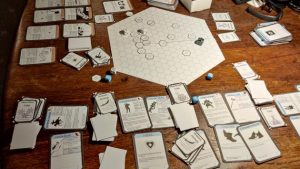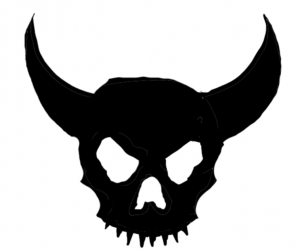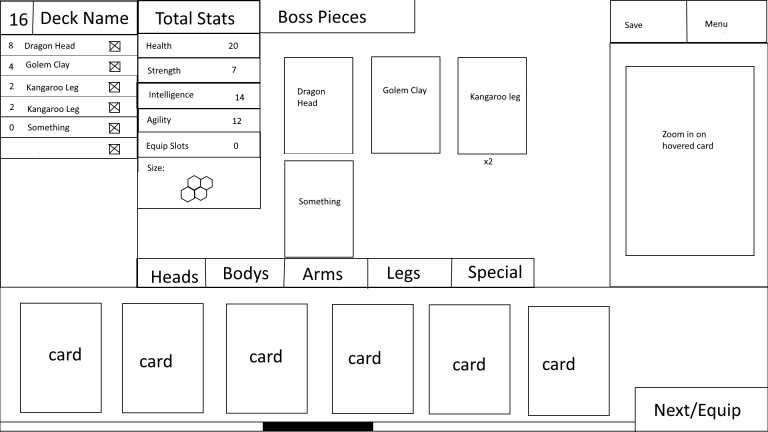


Boss Fight
Boss Fight’s development is currenty on pause. I am leading the project with the help of my brother Abraham Emdon, who is producing the games artwork.
The game is going to be prototyped as both a physical board game and in Unreal Engine using blueprints. I am the lead designer of the project, and the sole programmer. Abraham has been assisting with iterating on the game’s design and responsible for concepting and producing placeholder art.
Game Concept
Boss Fight is 2-5 player board game. One player builds a boss creature using a selection of different “boss piece cards”, the other players assemble a party of heroes from a pool of “hero cards”. Everyone then takes their characters to the board and engages in a battle between the boss and the heroes.
During setup phase all players get a set amount of points to spend on their character, this has to pay for the character (or body parts if you are the boss), the abilities and the equipment that the character can use. Each player also selects an action deck (or create one) to play their action cards from.
During battle phase all players place their chosen character piece on the board and take turns playing action cards. Action cards will allow the player to make actions such as moving, attacking or using an item.
The game ends when either the boss or the hero party are defeated, with the survivor/s being the victor.

Core Game Design Principles
Customisable progression systems offered in RPGs such as Dragon Quest 8 (Level-5, 2004) or Dungeons and Dragons (Greg Gyrax & Dave Arneson, 1974) have always interested me, I love being able to choose a character’s strength and weaknesses, then see a response to those decisions in gameplay. It adds more depth to character creation, which in itself is an inherently fun experience. Instead of just choosing what your hero is like, wouldn’t it be cool if you got to choose what the antagonist is like, and have the freedom to play with the types of powers these characters could have thematically, such as choice of the arena, control over an army or becoming a creature of inconceivable size and power.
Inspired by games such as Dark Souls (FromSoftware, 2011), I considered what it would be like to create a boss of epic proportion, having control over its appearance but also its stats, attacks, unique abilities, and features. Then test the creation against a willing party of heroes in a boss fight to see how powerful the creation really is. Instead of taking a narrative focused route such as in DnD, I wanted to focus the gameplay more on the strategy and fun in creating the boss creature and the heroes, then testing the creations to see how well they do in the fight.
If you would like to read further into the games documentation there is a link to the left with the Game Design Document.
Card Design
Hero Cards: Each card represents a hero. Each hero has their own stats, abilities and heroic feat. Stats affect how powerful the hero is in battle and affinity in different combat types, their abilities represent unique powers that the hero can use to gain advantages or disadvantages and the heroic feat is a powerful action that a hero can use once they gather enough resources.
Equipment Cards: Represents the weapons that a character is equipped with. Affects how much damage a character can deal, some have special effects.
Ability Cards: Represents additional abilities and knowledge you can give to your character, allows your character to attain unique powers that they wouldn’t otherwise have access to. E.g. parrying, healing or a final form.
Action Cards: Represent basic actions that each character can commit. Allows players to attack, move and use items.
The cards are currently blockouts, the layouts still need a bit of work but I’m working towards having the information as concise and clear as possible, with the most important information starting towards the top and centre of the card. I will also edit the layout design based on audience feedback when I playtest the game.


Setup Phase: Building Bosses and Heroes
A digital prototype allows for a lot of the game to be automated, meaning players don’t have to keep track of the maths themselves. The deck builder is currently being developed in the digital prototype using UE4 blueprints.
Striving for UX that is informative and clear. Important information such as the deck list and stats are seen first from the top left, then the card selector and deck display in the centre and finally the next page button in the bottom right.
Selecting each of the different cards in the deck is ordered and streamlined. Each card type is in a separate phase of the deck builder: choose character, then choose equipment, then choose ability, then choose actions. The screen isn’t too cluttered and confusing.
The deck list and character stats will remain through each of these screens so the player always knows what cards are in their deck and it’s stats.
Each card costs the player points. Players build their deck to have the same number of points as all players. Players have the freedom to create a character they like, build effective characters with powers that synergise or come up with wacky characters for fun.
Every cards point value represents its effectiveness. A point limit means no character is useless or overpowered. Players can choose their point limit and are free to pick the scale of their game.
Battle Phase
Take your character to the fight. See how your Hero or Boss Creature fares in battle.
Play action cards. Interact with allies and opponents by using actions.
Use your powers. Utilise the abilities you selected for your character to affect the battle in your favour (or not if you choose).
Build an emergent narrative. The interactions that occur between the characters tell a story to remember, make changes to your character between battles to reflect their development.

Reflection
Good points
– Enthusiastic about the concept and gameplay loop.
– Playable physical prototype for testing.
– Learning how to use UE4 Blueprints and the basics of programming.
– Character building is definitely fun, there is a lot of variation.
Points to improve on
– I am yet to approach the balancing of the game.
– The narrative for the games setting and world is still a bit empty.
– The card layouts could do with some work, they are still blockouts.
– The battle phase quite simplistic, it could use more depth.
While this project has developed considerably since concept it still has a long way to go. I am pleased with the development of the character builder, I am getting good feedback on it and I am developing my programming skills with blueprints quite quickly. When I have a little more spare time I will be putting the physical prototype forwards to play testers to learn more about how to improve the games balance and mechanics. I think the battle phase currently leaves a lot to be desired, and feedback from playtests will help me discover the best direction for it. At some stage I also want to work on building up the games setting and world, to add better flavour to the cards. Later down the line I will look into alternative card layouts and test which one players respond to best.
Bibiliography
– FromSoftware 2011, Dark Souls, videogame Playstation 3, Bandai Namco Games
– Gary Gygax, Dave Arneson 1974, Dungeons and Dragons, tabletop game, Wizards of the Coast.
– Level-5 2004, Dragon Quest 8, videogame, Playstation 2, Square Enix.

